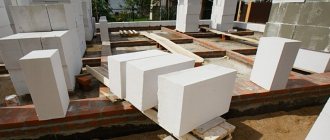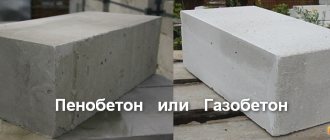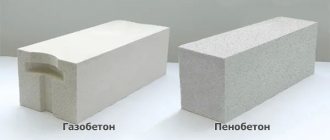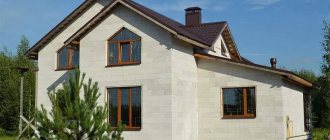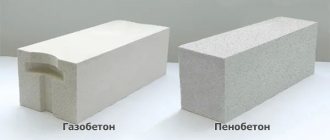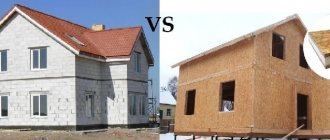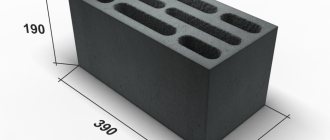For each specific task, you need your own brand of aerated concrete, which has an advantage in one or another parameter. In this article we will look at the brands, types, classes and main characteristics of gas blocks that will help you decide on your question. But first, let’s figure out what the brand means and draw up a table of brand correspondence to class and strength.
The grade of aerated concrete is a number that shows the density of the material. That is, the D300 brand means that the density of such aerated concrete is 300 kg/m3.
Note that this number is determined when the block is dry.
If aerated concrete is used for the construction of load-bearing walls , then autoclaved aerated concrete grade D400 is quite suitable for the construction of a one-story house. For a two-story building, it is better to use the D500. For taller buildings, aerated concrete grades D600 and higher are used. But we wrote this very conditionally, since by increasing the thickness of the blocks, the load-bearing capacity also increases.
For the construction of non-load-bearing external walls, brands D300, D400 are suitable. This option is often used in the construction of monolithic multi-storey buildings.
Brand of aerated concrete for partitions
Almost any brand is suitable
for interior partitions For partitions, sound insulation and the ability to fasten various hanging elements, such as shelves, cabinets, boilers, are important. In this regard, the D500/D600/D700 brands, with a thickness of 75 to 200 mm, are better suited. Brand, class, compressive strength
| Brand of aerated concrete | Compressive strength class | Average strength ( kg/cm²) |
| D300 (300 kg/m³) | B0.75 - B1 | 10 — 15 |
| D400 | B1.5 - B2.5 | 25 -32 |
| D500 | B1.5 - B3.5 | 25 — 46 |
| D600 | B2 - B4 | 30 — 55 |
| D700 | B2 - B5 | 30 — 65 |
| D800 | B3.5 - B7.5 | 46 — 98 |
| D900 | B3.5 - B10 | 46 — 13 |
| D1000 | B7.5 - B12.5 | 98 — 164 |
| D1100 | B10 - B15 | 131 — 196 |
| D1200 | B15 - B20 | 196 — 262 |
If we divide the brands of aerated concrete into types, they are divided into thermal insulation and structural . Thermal insulation grades have a density (up to 300 kg/m3), structural grades from 400 to 1200.
This division is explained simply: the higher the density of aerated concrete, the stronger it is, but at the same time it retains heat less well.
If you look at it in even more detail, it’s all about the air pores of aerated concrete, which affect the thermal, strength, sound insulation and other characteristics, but more on that later in the text.
It is very important to know that from different manufacturers of aerated concrete, with the same brand, the strength of the blocks can vary greatly.
After all, gas blocks are divided into autoclave and non-autoclave ; we have already described their differences in more detail in our article.
For now, we only note that autoclaved aerated concrete has much higher strength.
But if we compare the strength characteristics of gas blocks from well-known companies, such as Aeroc , StoneLight , UDK , then with the same brand their strength is approximately equal. These companies make a truly high-quality product using high-tech equipment.
Types of cellular concrete
There are 3 main types of cellular concrete:
- foam concrete;
- aerated concrete;
- gas silicate.
Foam concrete is made from cement mortar, to which a foam reagent consisting of many air bubbles is added. When thoroughly mixed, the material acquires a porous structure, and when it hardens, it turns into foam concrete. It is a non-autoclave cellular material.
Aerated concrete is made by mixing aluminum powder and cement mortar. These 2 components, when reacting, release hydrogen bubbles, increasing the initial volume of the mixture by 5 times. The resulting mixture is formed into blocks and placed in autoclaves, where the material hardens. This material is called autoclave.
Gas silicate is a type of aerated concrete. It differs in that its composition may not contain cement at all or contain a minimal amount of it. A silicate mixture is used as a binder.
Influence of brand on the characteristics of aerated concrete
Thermal conductivity . The lower the thermal conductivity coefficient, the better the heat is retained. For aerated concrete brand D350 , the thermal conductivity coefficient is from 0.075 (W/m2), and for a block of brand D700 - 0.25 (W/m2).
Strength and density . Let us repeat that the higher the density of aerated concrete, the stronger and cooler the block. The density of aerated concrete can be from 200 to 1200 kg/m3, which corresponds to the brand.
Fire resistance . Aerated concrete of any brand is fire-resistant, that is, it does not support combustion and can withstand high temperatures.
Vapor permeability . This parameter shows the ability of the material to transmit water vapor at a difference in partial pressure.
Characteristics and parameters
To understand where you can use D600 aerated concrete stone, you can familiarize yourself with its physical and technical properties :
- strength class – B5;
- thermal conductivity coefficient – 0.112;
- frost resistance – F100;
- fire resistance limit in minutes – 240;
- fire hazard class – K0(45);
- vapor permeability – 0.17;
- drying shrinkage – 0.35 mm/m.
The thermal conductivity of a gas block is determined not only in a dry state, but also when exposed to moisture . So, with a humidity of 5% the indicator will be 0.135.
Such blocks can withstand up to 100 cycles of defrosting and freezing of raw materials, and their weight is very easy to determine:
- To do this, you need to calculate the volume of the stone by multiplying all its sides.
- The result obtained must be multiplied by the density of the stone - 600, then the approximate mass of a unit of raw material can be calculated.
How does the brand of aerated concrete differ from the class?
The grade is called the average compressive strength, that is, in one batch of aerated blocks there may be blocks whose strength differs from each other by 10-20 percent. But on average for all blocks, the brand will be indicated on the packaging.
The class of aerated concrete shows the guaranteed strength of the blocks, which cannot be lower.
In other words, the brand is the average value of strength, and the class is the guaranteed value. For serious calculations, it is the strength class, not the brand, that is used.
Production technology
Procedure for the production of aerated concrete
The prepared components are loaded into the mixer in the following order:
- ash or sand sludge;
- water;
- Portland cement, lime, aluminum powder.
Additional components (gypsum, surfactants) are introduced simultaneously with binders. Aluminum powder first goes through a degreasing process and is mixed with a surfactant.
Sludge and water must have a temperature of +35°C before being added to the general mixture - in this case, the reaction of aluminum and calcium chloride will be more active.
All components before loading the gas generator 1-3 minutes. mix thoroughly. After adding the blowing agent, the mixture is actively stirred for another 3-5 minutes.
When producing aerated concrete, swelling of the material occurs in a special form by heating the solution, adding a surfactant and mechanical action. At this stage, 2 methods are used: casting and vibration swelling. With the 2nd method, the gas-forming agent is distributed more evenly in the solution, and the mixture becomes homogeneous.
After the material has cooled, the “top” is removed, the concrete is cut into blocks of the required size and placed in an autoclave for final hardening.
The procedure for producing foam concrete
Foam concrete hardens naturally when the material is periodically moistened so that it does not crack during the drying process. In this case, the output is a porous mass.
The technological process consists of several stages:
- technical foam is made in a foam frother;
- water and fiberglass are mixed in a mixer, then cement and sand are added, everything is thoroughly mixed and technical foam is introduced;
- the resulting solution is stirred for 3 minutes;
- the finished foam concrete is poured into molds.
The products are dried under natural conditions for 2 days. Then remove from the molds, lay in rows and leave for another 2 weeks, periodically moistening.
Dependence of sound insulation on the brand of aerated concrete
Sound insulation (noise absorption), this parameter is measured in decibels (dB), and shows what level of noise does not pass through the wall.
The thicker the wall, the better the level of sound insulation. The brand of aerated concrete directly affects sound absorption, and the higher the density, the less noise. Sound absorption table of aerated concrete
| Noise insulation index (dB) for different thickness of aerated concrete (mm) | |||||
| Brand of aerated concrete | 100 | 150 | 200 | 250 | 300 |
| D300 | 29 | 35 | 40 | 43 | 46 |
| D400 | 31 | 41 | 43 | 47 | 50 |
| D500 | 34 | 42 | 46 | 50 | 53 |
| D600 | 36 | 44 | 47 | 52 | 55 |
In other words, if a wall made of aerated concrete has a sound absorption of 40 dB, then quieter sounds will not pass through it, and if the sound from the street is 50 dB, then only 10 dB of them will pass through.
Material composition
When producing cellular concrete, the required components are:
- Portland cement (not lower than M400);
- silicate limestone powder.
Other components and fillers may include:
- blast furnace slag (ground);
- quartz sand;
- dry ash;
- ferroalloy slags;
- foaming agent;
- gasifier – aluminum powder;
- superplasticizers;
- granular foamed polystyrene;
- mica;
- clay.
All fillers are added to the mixture in finely ground form. Their part in the total composition of the mixture is 20-40%. Porosization of the material is ensured by introducing aluminum powder and calcium chloride into the solution. The liquid used is water with a low salt content. To improve the properties of cellular concrete, foamed polystyrene and hardeners are added, the content of which in the total mass of the mixture is minimal.
Table 1 - Ratio of components to obtain 1 cubic meter. m. cellular concrete
| Main components | Concrete D400 | Concrete D600-D1000 | Concrete D800 |
| Portland cement | 300 kg | 325 kg | 390 kg |
| Sand or sludge | 120 kg | 205 kg | 335 kg |
| Gas or foaming agent | 850 g | 1.05 kg | 1 kg |
| Water | 155 l | 182 l | 225 l |
Areas of application
The areas of use of PSB blocks depend on the density of the material:
- In classical construction. Structural products are used for the construction of main walls and partitions. There are ordinary and reinforced (reinforced) PSB blocks.
PSB facing blocks Source isd-group.ru
- In monolithic construction (as thermal insulation). The material is used both in the form of blocks and in liquid form. The mixture is prepared directly on site and is used for screeding floors, insulating roofs, pouring floors, and filling frames. It is also used as fireproof coatings.
- As a finishing material. We produce PSB masonry blocks with a decorative front side (with cladding) and finishing panels for façade cladding.
- As thermal insulation (insulation). Low density thermal insulation boards are produced.
- During the construction of chimneys and ventilation ducts.
Construction of a cottage from PSB blocks
A house made of polystyrene concrete with an area of 100-120 m2 on two floors can be erected in approximately 3 months. The process goes through the following stages:
- Foundation. The total weight of the structure is small, so the foundation is made less massive. Filling the basement walls with liquid polystyrene concrete makes it truly dry and warm.
- Walling. The structure grows quickly, but the blocks require careful installation; A reinforcing mesh is laid on top of each row, increasing the rigidity of the structure. To prevent the formation of cold bridges, the thickness of the glue in the seams is kept to a minimum.
Pouring interfloor slab Source rmnt.net
- Floor and ceiling coverings. They are made from PSB blocks or filled with liquid mortar. Before screeding the floor, water distribution throughout the house is arranged.
- Roof and communications. Installed in accordance with the project.
- Exterior finishing. It is carried out taking into account the characteristics of polystyrene concrete. Decorative facade PSB blocks with a textured front surface or plaster are popular.
